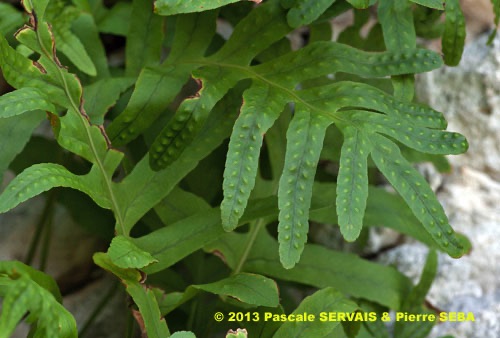
Polypodium cambricum L.
Fam. : Polypodiaceae
© Pascale SERVAIS & Pierre SEBA, 2018. Tilo Botanica: Flore de Tilos et du Dodécanèse / Flora of Tilos and of the Dodecanese
English translation by Brenda Bradbury, Howard Bradbury and Stéphane Léonard
Fougère vivace, en touffe plus ou moins étalée, à rhizome très écailleux.
Feuilles disposées à la base, vert jaunâtre pâle, persistantes, pennées, non coriaces, à pétiole assez long. Folioles étroites, lancéolées, dentées, glabres, à nervure médiane bien visible et à nervures latérales à 3 bifurcations (voir par transparence).
Sporanges mêlés de poils courts, en groupes ovales ou elliptiques, disposés sur 1 rang de chaque côté de la nervure médiane sur le dessous des folioles fertiles.
___________________________
Fern perennial, tufted, more or less spread out, with a very scaly rhizome.
Leaves laid out to the base, pale yellowish green, persistent, pinnate, nontough, with a rather long petiole. Leaflets narrow, lanceolate, toothed, glabrous. Median rib quite conspicuous and lateral ribs with 3 junctions (see by transparency).
Sporangia mingled with short hairs, joined together in ovate or elliptic groups laid out on 1 row on each side of the median vein on the lower part of the fertile leaflets.
Descripteurs / Identifying features
1
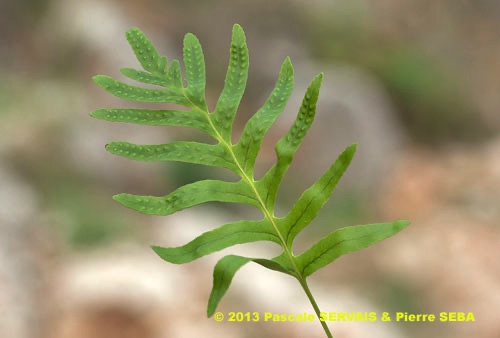
2
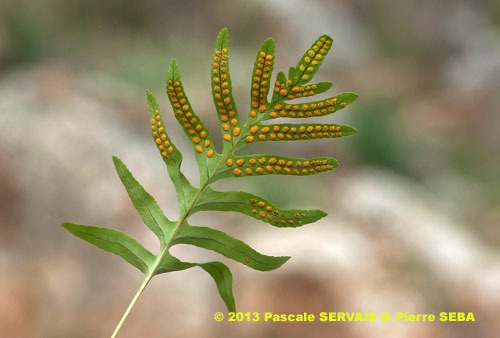
3
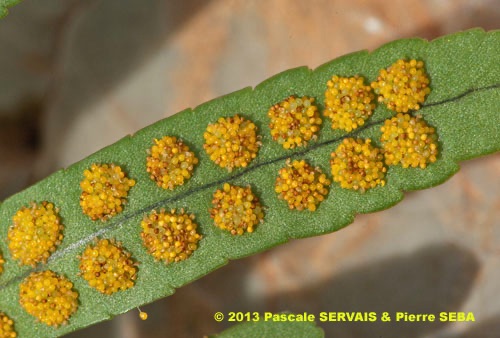
4
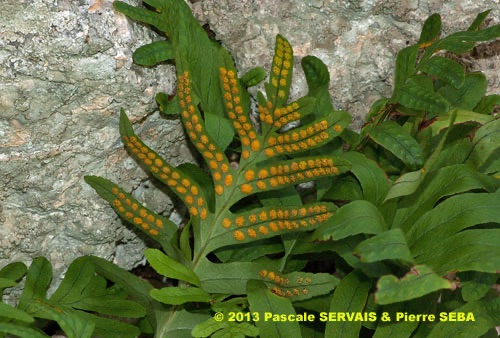
5
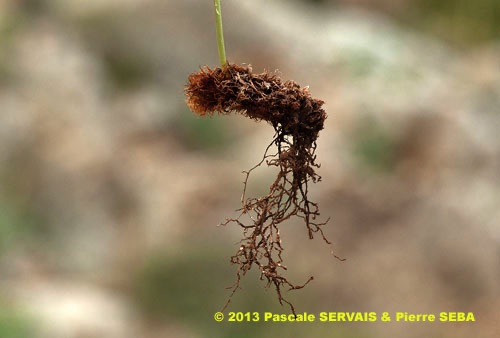
6
Étymologie / Etymology :
Polypodium : emprunt du latin polypodium, -i (nom) = le polypode, nom
donné à la plante par Pline, naturaliste latin mort en 79 apr. J.-C.,
forme latinisée du grec ancien πολυπόδιον, -ου (nom)
[ < πολύς, πολλή, πολύ (adj.) = beaucoup + πόδιον, -ου (nom)
= le petit pied ] = le polypode, nom donné à la plante par Dioscoride,
médecin et botaniste grec mort en 90 apr. J.-C., en référence aux
nombreuses radicelles du rhizome ou à la disposition des sores sur la
fronde, ressemblant vaguement à un mille-pattes.
Cambricum : emprunt du latin médiéval cambricus, -a, -um (adj.)
= du Pays de Galles, qui vient du Pays de Galles.
Polypodium : borrowed from Latin polypodium, -i (noun) = polypody,
name given to the plant by Plinius, Latin naturalist died in 79 AD,
Latinized form of the Classical Greek πολυπόδιον, -ου (noun)
[ < πολύς, πολλή, πολύ (adj) = many + πόδιον, -ου (noun) = little foot ]
= polypody, name given to the plant by Dioscorides, Greek doctor and
botanist died in 90 AD, referring to the many radicles of the rhizome or
to the position of the sori on the frond, vaguely resembling a centipede.
Cambricum : borrowed from medieval Latin cambricus, -a, -um (adj)
= of or from Wales, which comes from Wales.
Synonymes / Synonyms :
Polypodium australe Fée
Polypodium australe var. cambricum (L.) Kunkel
Polypodium cambricum subsp. australe (Fée) Greuter & Burdet
Polypodium cambricum subsp. serrulatum (Arcang.) Pic.Serm.
Polypodium laciniatum Lam.
Polypodium serratum (Willd.) A.Kern.
Polypodium virginianum sensu Hess & Landolt
Polypodium vulgare subsp. cambricum (L.) Arcang.
Polypodium vulgare subsp. serratum (Willd.) Christ
Polypodium vulgare subsp. serrulatum Arcang.
Polypodium vulgare var. acutilobum Salis
Polypodium vulgare var. cambricum (L.) Lightf.
Polypodium vulgare var. caprinum Christ
Polypodium vulgare var. hibernicum T.Moore
Polypodium vulgare var. semilacerum Woll.
Polypodium vulgare var. serratum Willd.
Noms vernaculaires / Common names :
Noms français / French names :
Polypode austral — Polypode du Sud.
Nom anglais / English name :
Southern polypody.
Nom allemand / German name :
Südlicher Tüpfelfarn.
Noms espagnols / Spanish names :
Filipodio — Polipodio.
Noms italiens / Italian names :
Polipodio del Galles — Polipodio mediterraneo —
Polipodio meridionale.
Habitat :
Murs, rochers.
Walls, rocks.
Île / Island :
Tilos.
Hauteur / Height range :
De 10 cm à 30 cm.
From 10 cm to 30 cm.
Maturation des spores / Ripening of the spores :
De décembre à avril.
From December to April.
Groupe / Classification :
Ptéridophytes.
Pteridophytes.
Pérennité / Lifespan :
Vivace.
Perennial.
Description :
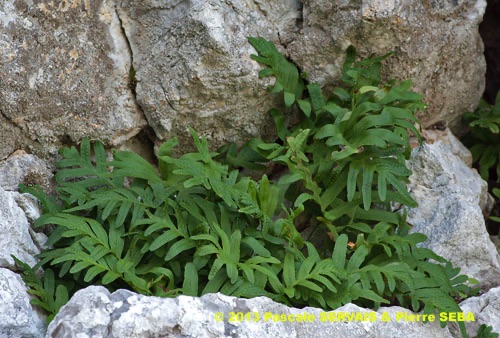
7
Photo 1 :
Localisation / Location : Tilos, Megalochorio, Grotte des éléphants
Date : 23/01/2013
GPS : Lat. 36,44062° N / Long. 27,36524° E / Alt. 152 m
Type : Photographie numérique / Digital Photograph (10 mégapixels)
Photo 2 :
Localisation / Location : Tilos, Megalochorio, Grotte des éléphants
Date : 23/01/2013
GPS : Lat. 36,44062° N / Long. 27,36524° E / Alt. 152 m
Type : Photographie numérique / Digital Photograph (10 mégapixels)
Photo 3 :
Localisation / Location : Tilos, Megalochorio, Grotte des éléphants
Date : 23/01/2013
GPS : Lat. 36,44062° N / Long. 27,36524° E / Alt. 152 m
Type : Photographie numérique / Digital Photograph (10 mégapixels)
Photo 4 :
Localisation / Location : Tilos, Megalochorio, Grotte des éléphants
Date : 23/01/2013
GPS : Lat. 36,44062° N / Long. 27,36524° E / Alt. 152 m
Type : Photographie numérique / Digital Photograph (10 mégapixels)
Photo 5 :
Localisation / Location : Tilos, Megalochorio, Grotte des éléphants
Date : 23/01/2013
GPS : Lat. 36,44062° N / Long. 27,36524° E / Alt. 152 m
Type : Photographie numérique / Digital Photograph (10 mégapixels)
Photo 6 :
Localisation / Location : Tilos, Megalochorio, Grotte des éléphants
Date : 23/01/2013
GPS : Lat. 36,44062° N / Long. 27,36524° E / Alt. 152 m
Type : Photographie numérique / Digital Photograph (10 mégapixels)
Photo 7 :
Localisation / Location : Tilos, Megalochorio, Grotte des éléphants
Date : 23/01/2013
GPS : Lat. 36,44062° N / Long. 27,36524° E / Alt. 152 m
Type : Photographie numérique / Digital Photograph (10 mégapixels)

Google Maps
Google Maps
Google Maps
Google Maps
Google Maps
Google Maps
Google Maps